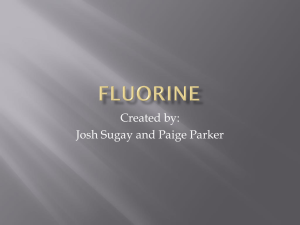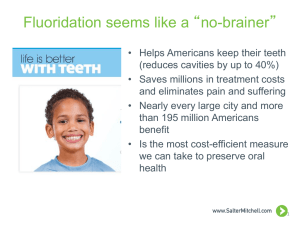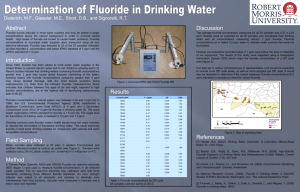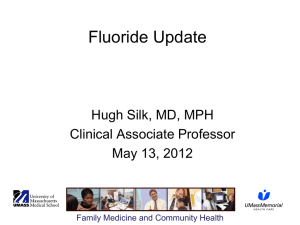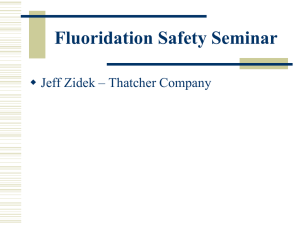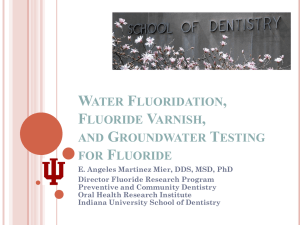Brief history of Water Fluoridation
advertisement
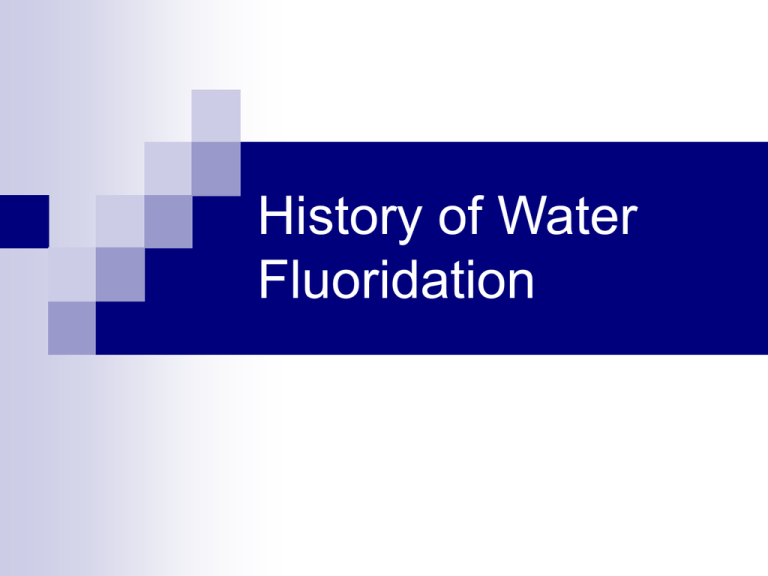
History of Water Fluoridation History of Water Fluoridation Two stories unfolded over more than half a century: The story of the harmful effects of fluoride in large doses The story of dental benefits from small doses Harmful effects of fluoride The first important mention of the fluorosis occurred in 1902 in El Paso County, Colorado By Frederick S. McKay. McKay gave systematic attention to the mottling and brown staining he found on the teeth of many of his patients and hypothesized it’s due to water supply. Harmful effects of fluoride Harmful effects of fluoride By 1908 McKay studied enough cases and interested enough colleagues to invite Dr. G. V. Black, then Dean of Northwestern University Dental School to join him in the study. Black’s visit gained national attention to the phenomenon and afterwards many cases were reported from other parts of the country. The name “Colorado brown stain” eventually gave way to that of mottled enamel and the process soon became associated with communal water supplies, usually from deep wells – “deep well hypothesis” Harmful effects of fluoride In Britton, South Dakota, in 1916 a study revealed uniformed mottling of enamel among the children brought up in the town since a new deep well had been added to the communal water supply in 1898. In 1925, citizens of Oakley, Idaho, where mottling was prevalent, undertook to test the deep well hypothesis by changing from a warm spring-water supply (artesian water) to another shallower water supply: In succeeding years, the children on the new water supply developed no mottling, but the children brought up on the old supply were not cured. Harmful effects of fluoride In 1925, McCollum, Bunting and others did experiments on rats and found that rats, fed in excess of fluoride developed staining in incisors. At the time this wasn’t connected to stains in enamel in humans . Harmful effects of fluoride Studies initiated in 1928 in Bauxite, Arkansas, led to the final discovery that mottled enamel was associated with fluoride in water An exceptionally high incidence of mottling occurred in this town, and the action upon the problem was more farreaching than usually because of presence of a plant of Republic Mining and Manufacturing Company, a subsidiary of the Aluminum Corporation of America. Samples of Bauxite water eventually came to the laboratory of H. V. Churchill, chief chemist for Alcoa, who initiated spectrographic study.13.7 parts per million of fluoride were found in the Bauxite water! McKay was notified in 1931. Harmful effects of fluoride Following this McKay arranged for reanalysis of the water supplies in Britton, South Dakota, Oakley, Idaho, and elsewhere. Subsequent rechecking in many parts of the United States soon developed a striking correlation between mottled enamel and a fluoride content of public water ranging from 2 to 13 parts per million. At the same time Smiths in Arizona and Velu in France made similar connection between mottled enamel and fluoride, but this didn’t spark as much interest. Dental benefits of fluoride The coexistence of low dental caries and mottled enamel had excited comment from McKay, even in the early years of his investigation. After the discovery that fluoride correlated with mottled enamel in 1931, several other investigations also noted this inverse relation. Caries Dental benefits of fluoride Dr. H. Trendley Dean, on duty with the US Public Health Service, made a thorough documentation of the degree of mottled enamel and degree of caries at different concentrations of fluoride. As it became obvious that large reductions in caries incidence were associated with the occasional appearance of enamel opacities that were in no way disfiguring, the term mottled enamel gave way to the more exact term dental fluorosis. 1939 Cox and his coworkers suggested that supplying optimum amount of fluorine during the tooth-forming years could considerably reduce dental caries. Dental benefits of fluoride 1941-42. Dean HT (National Institute of Health) reported on examination of 7,257 continuous-residence white children of 21 cities with differing amounts of fluorides in their community waters. Dental benefits of fluoride Dental benefits of fluoride Dental benefits of fluoride The studies established: Children 12-14 who have continuously, since birth, used water with an optimal fluoride concentration have, in general about twothirds less dental decay than children who used fluoride-free drinking water. Lessened amount of dental caries follows the use of a domestic water containing as low as1.0 ppm of fluoride. Three pilot studies (started 1945) Newburgh, New York, with Kingston as a control. Grand Rapids, Michigan, with Muskegon as a control. Brantford, Ontario. Newburgh – Kingston study 1942 Ast prepared a thesis on the cariesfluorine hypothesis in which he suggested a plan to test this hypothesis. 1943. A favorable report was made to Edward S. Godfrey M.D., then the State Commissioner of Health. Newburgh and Kingston were chosen for the study Newburgh – Kingston study In March, 1944 the City Council of Newburgh approved the water fluoridation Following this many complaints were received from local citizens in the span of one year: Discoloring sauce-pans Digestive disturbances One complaint about water causing a denture to crack. Newburgh – Kingston study But it was not until May 2, 1945 that the water was fluoridated! Local paper carried an editorial which pointed out to the people how some persons can imagine all sorts of disabilities from nonexistent causes. This ended the complaints. Newburgh – Kingston study Dental caries measurements (by one dentist) in 612 year olds for both cities (1944-45) demonstrated close comparability Annual clinical examinations in both cities (194455). Supplemented with roentgenograms (194950, 53-54, 54-55) Several reports published. All showed improvements in Newburgh and lack thereof in Kingston Newburgh – Kingston study Newburgh – Kingston study At the same time Pediatrics study was conducted in the cities (with Kingston as a control). Annual visits of children to the study clinic. After 10 years of water fluoridation no differences of medical significance could be found between the two groups of children. Grand Rapids 1945 Grand Rapids, Mich began water fluoridation Presented findings are from 1950 Study compares: Rapids, Mich – water fluoridation Muskegon, Mich – control (similar climate) Aurora, Ill – naturally fluoridated water supply Grand Examinations of virtually the entire school populations in continuous residence. Grand Rapids Findings reported in: def (decayed, extraction indicated, or filled) for deciduous teeth DMF (decayed, missing, or filled) for permanent teeth Grand Rapids Grand Rapids Brantford – Sarnia – Stratford 1945 Brantford, ON began water fluoridation Final Survey, 1963 Study compares: – water fluoridation Sarnia – negligible amount of fluoride in water Stratford – naturally fluoridated water supply Brantford Native, Continuously Resident 16-17-YearOld Children were examined (n = 356, 482 and 227 respectively). Brantford – Sarnia – Stratford All examinations done by the same examiner Findings are presented in respect to (1) all permanent teeth, and (2) permanent upper incisors. Brantford – Sarnia – Stratford Indices used to measure caries-prevalence: % of caries-free children Permanent teeth Upper incisors Tooth mortality rate DMF (decayed, missing, filled): Permanent teeth per child Permanent upper incisors Brantford – Sarnia – Stratford Brantford – Sarnia – Stratford Brantford – Sarnia – Stratford Brantford – Sarnia – Stratford Dental benefits of fluoride The End

